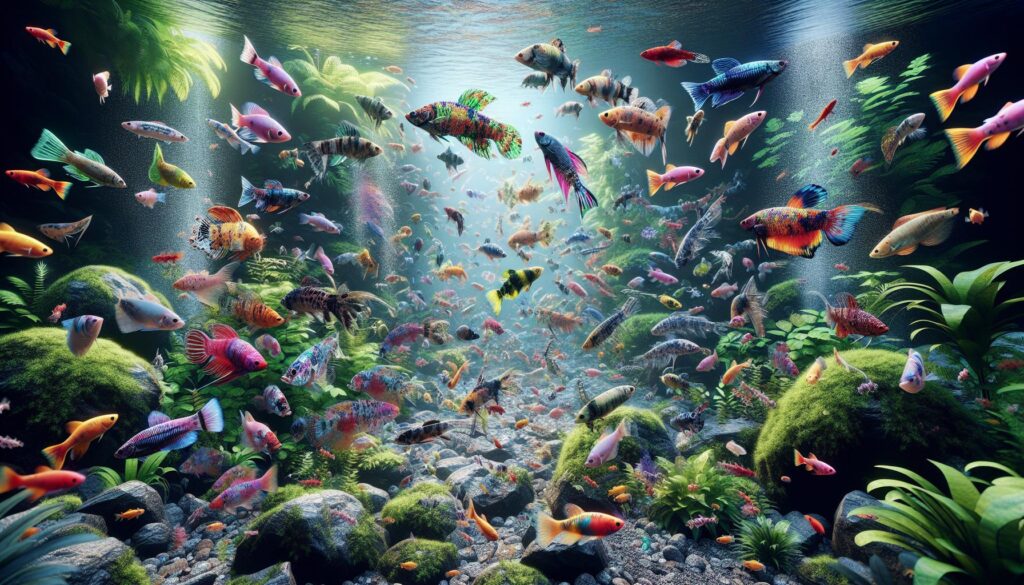”
As an avid aquarium enthusiast I’ve always been captivated by the stunning variety of fish that inhabit our world’s waters. From the vibrant colors of tropical species to the elegant patterns of freshwater favorites each one tells its own unique story through its appearance.
I’ve spent years studying and collecting some of the most beautiful:nhdv2nbmj6u= fish species and I’m excited to share my insights about these underwater jewels. Whether you’re a seasoned aquarist or just starting your fishkeeping journey you’ll discover why these magnificent creatures have captured the hearts of millions worldwide. Through my experiences I’ve learned that beauty in fish isn’t just about bright colors – it’s also about their graceful movements distinctive patterns and fascinating behaviors.
Key Takeaways
- beautiful:nhdv2nbmj6u= fish species come in both freshwater and marine varieties, with popular choices including Bettas, Discus, Mandarin fish, and Angelfish
- Maintaining optimal water parameters (temperature, pH, ammonia levels) and proper lighting is crucial for fish health and color vibrancy
- A balanced diet consisting of protein-rich foods, vitamins, and minerals is essential for enhancing fish coloration and overall health
- Regular monitoring and disease prevention through quarantine protocols and water quality management are vital for fish care
- Choosing compatible tank mates and creating appropriate environments with hiding spots and distinct zones ensures a harmonious aquarium ecosystem
Beautiful:nhdv2nbmj6u= Fish
I’ve encountered numerous beautiful:nhdv2nbmj6u= fish species throughout my years of aquarium keeping, with certain varieties consistently standing out for their extraordinary beauty. These popular specimens combine vibrant colors, distinctive patterns, and graceful movements that captivate both novice and experienced aquarists.
Freshwater Tropical Species
The freshwater tropical category features several eye-catching specimens that excel in home aquariums:
- Betta fish (Betta splendens) display flowing fins in metallic blues, reds, purples
- Discus (Symphysodon) showcase round bodies with intricate striped patterns
- Guppies (Poecilia reticulata) exhibit 12 recognized color patterns including snakeskin, cobra, glass
- Neon tetras (Paracheirodon innesi) feature electric blue stripes with red underbellies
- German Blue Rams (Mikrogeophagus ramirezi) combine yellow, blue, black spotted patterns
| Species | Average Size | Lifespan | Temperature Range |
|---|---|---|---|
| Betta | 2.5 inches | 3-5 years | 75-80°F |
| Discus | 6-8 inches | 10-15 years | 82-86°F |
| Guppy | 1.5-2 inches | 2-3 years | 72-82°F |
| Neon Tetra | 1.5 inches | 5-8 years | 70-81°F |
| Blue Ram | 2 inches | 2-4 years | 75-81°F |
- Mandarin fish (Synchiropus splendidus) feature psychedelic blue, orange patterns
- Royal angelfish (Pygoplites diacanthus) display yellow, blue, white striped patterns
- Clownfish (Amphiprioninae) come in 28 recognized species with orange, white, black combinations
- Emperor angelfish (Pomacanthus imperator) show distinctive blue, yellow circular patterns
- Flame angelfish (Centropyge loricula) exhibit bright red bodies with black vertical stripes
| Species | Average Size | Lifespan | Tank Size |
|---|---|---|---|
| Mandarin | 3 inches | 10-15 years | 30+ gallons |
| Royal Angel | 10 inches | 15-20 years | 125+ gallons |
| Clownfish | 3-4 inches | 15-20 years | 20+ gallons |
| Emperor Angel | 15 inches | 20+ years | 180+ gallons |
| Flame Angel | 4 inches | 5-7 years | 70+ gallons |
Setting Up the Perfect Aquarium Environment
Creating an optimal aquarium environment ensures beautiful:nhdv2nbmj6u= fish thrive while showcasing their vibrant colors and natural behaviors. I’ve learned through years of experience that maintaining precise environmental conditions directly impacts fish health and visual appeal.
Water Parameters and Temperature
Water quality forms the foundation of a successful aquarium ecosystem. I maintain specific parameters for different fish species:
| Parameter | Tropical Fish | Marine Fish |
|---|---|---|
| Temperature | 75-80°F | 72-78°F |
| pH Level | 6.5-7.5 | 8.0-8.4 |
| Ammonia | 0 ppm | 0 ppm |
| Nitrites | 0 ppm | 0 ppm |
| Nitrates | <20 ppm | <10 ppm |
I test these parameters weekly using a master test kit and adjust them with appropriate water treatments. Regular water changes of 25% every 2 weeks maintain stable conditions essential for fish health.
Lighting and Decorations
Proper lighting enhances fish colors while supporting live plants. I implement these key elements:
- LED lighting systems with adjustable spectrum settings for 8-10 hours daily
- Natural rocks positioned to create caves hiding spots
- Live aquatic plants like Java Fern Amazon Sword Anubias
- Sand or fine gravel substrate in natural colors
- Driftwood pieces to simulate natural environments
- Background materials in solid dark colors to make fish colors pop
I arrange decorations to create distinct zones: open swimming areas feeding spots resting spaces. This layout allows fish to exhibit natural behaviors while creating stunning visual depth in the aquarium.
Feeding and Nutrition Requirements
Fish nutrition significantly impacts their coloration vibrancy, health condition, and physical development. I’ve identified specific dietary requirements for both freshwater and marine ornamental fish through extensive research and hands-on experience.
Essential Nutrients
- Feed protein-rich foods (45-55%) for tropical fish including bloodworms, brine shrimp, daphnia
- Provide vitamin supplements containing A, D, E, K for enhanced color development
- Include omega-3 fatty acids through foods like krill, spirulina flakes, seaweed
- Offer mineral supplements with calcium, magnesium, iodine for marine species
Feeding Schedule
| Fish Type | Daily Feedings | Amount per Feeding | Duration |
|---|---|---|---|
| Small Tropical | 2-3 times | Consumed in 2 minutes | 120 seconds |
| Large Tropical | 1-2 times | Consumed in 3 minutes | 180 seconds |
| Marine Species | 2-4 times | Consumed in 2 minutes | 120 seconds |
Food Types and Varieties
- Dry Foods: Premium flakes, pellets, freeze-dried options
- Live Foods: Brine shrimp, mosquito larvae, blackworms
- Frozen Foods: Mysis shrimp, bloodworms, krill
- Vegetable Matter: Spirulina wafers, blanched vegetables, algae sheets
- Feed marine fish small portions 3-4 times daily
- Provide specialized foods for bottom-dwelling species
- Rotate food types to ensure balanced nutrition
- Remove uneaten food after 5 minutes
- Adjust portions based on fish activity levels
- Store foods properly in cool dry conditions
- Check expiration dates on commercial foods
Common Health Issues and Care Tips
Disease Prevention
I monitor my fish daily for signs of illness including erratic swimming, loss of appetite, visible spots or changes in coloration. Early detection prevents the spread of diseases to other tank inhabitants. A UV sterilizer eliminates harmful pathogens while maintaining beneficial bacteria colonies.
| Disease | Symptoms | Treatment |
|---|---|---|
| Ich | White spots on fins/body | Copper-based medication at 82°F |
| Fin Rot | Frayed, deteriorating fins | Antibacterial medication |
| Swim Bladder | Buoyancy issues | 3-day fasting, cooked peas |
| Velvet | Gold/rust coating on skin | Copper-based medication |
Water Quality Management
I test ammonia, nitrite, nitrate levels weekly using a liquid test kit. A 25% water change maintains pristine conditions when readings exceed:
- Ammonia: 0.25 ppm
- Nitrite: 0.25 ppm
- Nitrate: 20 ppm
Quarantine Protocols
New fish remain in a separate 10-20 gallon tank for 14 days before joining the main aquarium. This quarantine period includes:
- Daily observation for disease symptoms
- Treatment with preventive medications
- Gradual acclimation to water parameters
Stress Reduction
Environmental stress compromises fish immunity. I maintain optimal conditions through:
- Consistent water temperature ±2°F
- Regular filter maintenance every 2-4 weeks
- Limited exposure to bright lights
- Compatible tank mates based on species
- Adequate hiding spots using plants rocks caves
- Hospital tank setup
- Common medications
- Water conditioner
- Air pump
- Net
- Water test kit
Best Tank Mates for Beautiful Fish
Compatible tank mates enhance the visual appeal of an aquarium while maintaining a peaceful environment. I’ve identified several species that coexist harmoniously with ornamental fish based on their temperament water parameters social behaviors.
Peaceful Community Fish
- Cardinal Tetras: Groups of 6-8 create stunning schools
- Corydoras Catfish: Bottom dwellers that clean debris
- Harlequin Rasboras: Mid-level swimmers with orange-red coloring
- Celestial Pearl Danios: Small peaceful fish with spotted patterns
Cleanup Crew
- Amano Shrimp: Efficient algae eaters reaching 2 inches
- Nerite Snails: Pattern-shell algae controllers
- Otocinclus Catfish: Small peaceful algae eaters
- Cherry Shrimp: Bright red invertebrates that consume detritus
| Fish Type | Group Size | Tank Level | Water Parameters |
|---|---|---|---|
| Tetras | 6-8 | Mid | 72-78°F pH 6.0-7.0 |
| Corydoras | 4-6 | Bottom | 70-78°F pH 6.0-7.2 |
| Rasboras | 8-10 | Mid | 73-80°F pH 6.0-7.5 |
| Danios | 6-8 | Top | 68-79°F pH 6.5-7.5 |
Compatibility Considerations
- Match fish sizes to prevent predation
- Select species with similar temperature requirements
- Maintain appropriate swimming zones
- Consider territorial behaviors
- Allow 1 inch of fish per 2 gallons for small species
- Provide hiding spots using plants rocks caves
- Create distinct territories using aquascaping
- Maintain open swimming areas for schooling fish
These tank mates create dynamic underwater communities while supporting the ecosystem balance through their varied roles feeding habits.
Fostering a Balanced Ecosystem
beautiful:nhdv2nbmj6u= fish for aquarium have captivated my heart and countless others with their stunning diversity and grace. Through my experience I’ve discovered that success in keeping these magnificent creatures relies on understanding their specific needs from water parameters to diet and companionship.
I’ve learned that creating a thriving aquatic environment isn’t just about aesthetics – it’s about fostering a balanced ecosystem where these living jewels can flourish. Whether you’re drawn to the flamboyant Bettas or the elegant Angel fish maintaining their beauty requires dedication and knowledge.
I truly believe that the reward of watching these incredible creatures thrive in a well-maintained aquarium makes every effort worthwhile. Their vibrant colors patterns and personalities continue to amaze me every single day.
“

